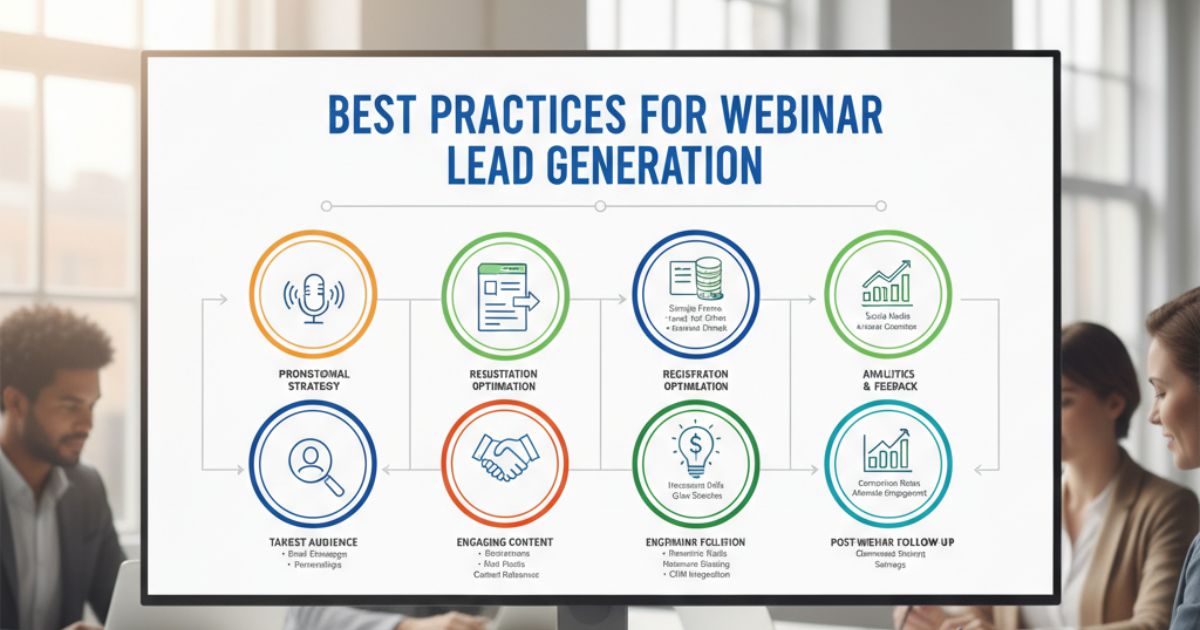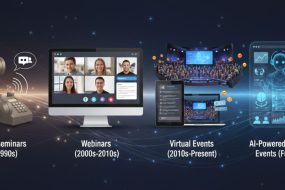
Marketing teams are constantly searching for the most reliable way to generate high-quality B2B leads. They need a channel that not only captures attention but also builds genuine connections, nurtures buyer intent, and drives predictable sales pipeline growth. While social media algorithms shift and email marketing performance fluctuates, one channel continues to outperform the rest: B2B webinars.
For more than two decades, webinar marketing, virtual events, and online workshops have consistently delivered stronger lead quality, deeper engagement, and higher conversion rates than many modern channels. This isn’t because webinars are old-fashioned—it’s because the data proves how effective they are in today’s B2B demand generation landscape.
Webinars succeed because they blend thought leadership, educational content, and interactive engagement tools such as live Q&As, polls, chat, and on-demand replays. This creates a powerful environment where marketing teams can attract high-intent prospects, nurture them through the funnel, and turn them into sales-ready opportunities.
So why do webinars remain the most effective channel for B2B lead generation, and how can companies leverage them to maximize ROI, increase attendee engagement, and accelerate revenue growth?
The Numbers Don’t Lie: Webinar Performance Statistics

Webinar marketing delivers strong, measurable results that often beat other B2B lead generation channels. On average, webinars achieve conversion rates of 20% to 40%, far higher than traditional content marketing methods, which usually see 2% to 5% conversions.
A typical webinar attracts about 260 registrants, with attendance rates between 40% and 50%. Even more importantly, the leads from webinars are high-quality, with 73% of B2B marketers saying webinars are the most effective way to generate qualified leads.
These results show how B2B buyers prefer to consume information. Instead of downloading more whitepapers or reading blog posts, decision-makers value live interaction with experts, where they can ask questions and get answers relevant to their challenges.
Interactive Learning Creates Stronger Connections
Webinars are more than a slide deck and a speaker—they’re interactive learning experiences that help brands build deeper, more meaningful B2B connections. Unlike static content such as blogs, eBooks, or whitepapers, webinars give prospects the chance to engage directly with your team in real time. This makes the experience more dynamic, more personal, and far more aligned with today’s B2B buyer journey.
When attendees can ask questions live and get immediate, expert-level answers, it naturally builds trust and positions your brand as a credible authority in your industry. Real-time Q&A sessions often reveal insights about buyer needs, pain points, and purchase intent—data that many other demand generation channels can’t easily capture.
Modern webinar platforms like Zoom Webinars, ON24, GoToWebinar, and HubSpot Webinars amplify this impact through engagement tools such as live polls, chat interactions, surveys, quizzes, and breakout rooms. These features turn passive viewers into active participants, increasing attention and improving content retention.
And the outcome? Higher-quality leads, stronger brand affinity, and better conversion rates. When prospects feel heard, involved, and connected, they’re far more likely to move forward in the pipeline and become sales-ready opportunities.
Educational Value Builds Trust and Authority
The most effective webinar marketing strategies focus on educating the audience first and selling later. This aligns perfectly with how today’s B2B buyers make decisions. Before they ever speak to a sales rep, they research their challenges, compare solutions, and look for credible insights from trusted sources like LinkedIn, Gartner, or Forrester.
When companies prioritize genuine educational value in their webinars, they position themselves as trusted advisors—not just vendors pushing a product. In B2B markets, where decisions often involve long sales cycles, multiple stakeholders, and significant budgets, this trust-building stage is critical.
Webinars give brands the opportunity to showcase expertise in ways that static content can’t. Through live demos, screen sharing, case studies, and interactive presentations led by subject-matter experts, companies can break down complex topics and make them easier to understand. Platforms like Zoom, Demio, ON24, or HubSpot Webinars also make it simple to engage audiences with visuals and real-world examples.
This educational approach naturally boosts thought leadership, strengthens brand authority, and leads to higher-quality, more sales-ready B2B leads. When prospects learn something meaningful from you, they’re far more likely to see your brand as the go-to solution provider.
Qualified Audience Self-Selection
One big advantage of webinar marketing is that it brings in a naturally qualified audience. People do not register for a webinar by mistake. They sign up because the topic matters to them and they want help with a real problem.
The registration form acts as the first filter. When someone shares their name, email, company, and job role, it shows real interest. If they choose to spend 30–60 minutes attending, that is a strong sign they are already in the B2B buying journey.
Webinar attendance gives even more qualification signals. Prospects who stay until the end, join the chat, answer polls, or ask questions are showing high intent. These actions tell your team who is most interested.
Tools like HubSpot, Marketo, Salesforce, Zoom Webinars, and ON24 can track these engagement signals. They send the data straight to your CRM or marketing automation platform. This helps sales teams see which leads are ready for follow-up.
Repurposing Content Maximizes ROI
A single webinar can create many types of content that support B2B lead generation for months. The recording becomes an on-demand video that keeps bringing in qualified leads long after the live event is over.
You can turn one webinar into blog posts, social media clips, email newsletters, slide decks, and even podcast episodes. This “content repurposing” approach helps marketing teams get more value from the time and effort they invested.
Many companies find that recorded webinars generate as many—or even more—leads than the live sessions. Since recordings can be promoted continuously and accessed by prospects in different time zones, incorporating a strong webinar strategy makes them a powerful evergreen lead generation tool, extending audience reach and strengthening overall marketing performance.
By repurposing webinar content, B2B brands can reach a bigger audience, improve marketing performance, and get a higher ROI from every webinar they host.
Integration with Modern Sales Processes
Webinars fit easily into account-based marketing (ABM) and modern B2B sales processes. Sales teams can use webinar data to choose which leads to contact first. They can also personalize their messages based on the topics each prospect viewed or interacted with.
Advanced webinar analytics show how engaged each attendee was. This helps sales teams find the strongest leads. For example, a person who watched 90% of the webinar and asked questions is more valuable than someone who left early.
This data-driven approach brings marketing and sales teams together. It improves lead scoring, sales enablement, and the handoff between both teams. When webinar engagement data connects to CRM tools like HubSpot, Salesforce, or Marketo, companies get a smoother and more efficient sales workflow.
Webinars give teams the insights they need to make smarter follow-ups and close deals faster.
Overcoming Common Webinar Challenges
Webinars are very effective for B2B lead generation, but they do come with challenges. Low attendance is a common issue. The solution is targeted promotion and choosing topics that address urgent prospect problems.
Technical issues can also disrupt a live webinar. Using reliable platforms like Zoom, ON24, or GoToWebinar, and testing everything before the event, helps avoid most problems. Having a backup plan and technical support ready ensures a smooth experience.
Some marketers worry that webinars are oversaturated. But high-quality, value-driven content still attracts attendees. The key is to focus on prospect needs and educational content, rather than just promoting products.
By prioritizing value and a prospect-focused approach, companies can overcome these challenges. The result is higher engagement, stronger trust, and better-quality B2B leads.
Best Practices for Webinar Lead Generation

Successful webinar marketing starts with careful planning. Pick topics that solve real problems your target audience faces. Avoid focusing only on product or service features. The best webinars educate first and introduce solutions second.
Promotion is just as important as the content. Use multi-channel promotion, including email campaigns, LinkedIn posts, social media, and partner networks, to boost registrations. Personalized invitations from sales team members often get better results than generic marketing emails.
Follow-up is where many companies lose opportunities. A structured lead nurturing sequence helps provide more value and guide prospects toward sales conversations. This approach strengthens B2B relationships, increases conversion rates, and ensures high-quality leads move smoothly through the sales funnel.
Webinars work best when content, promotion, and follow-up all work together.
The Future of B2B Lead Generation Starts Here
Webinars have proven their value in B2B lead generation. They combine education, audience interaction, and trust-building in ways that other channels often cannot. Even as marketing trends change, the core benefits of webinars—high-quality leads, engagement, and brand authority—remain strong.
Companies that master webinars today will gain a competitive advantage. Start with one monthly webinar focused on your audience’s most urgent challenges. Then expand gradually as your program grows.
By prioritizing virtual events that educate and engage, your B2B marketing team can build stronger relationships with prospects. This approach improves conversion rates, nurtures high-intent leads, and drives long-term business growth.
FAQs
1. Why are webinars effective for B2B lead generation?
Webinars combine educational content, live interaction, and audience engagement, which helps B2B companies attract high-quality leads and build trust with prospects.
2. How many leads can a typical B2B webinar generate?
On average, a single webinar attracts around 260 registrants with 40–50% attendance rates. Many companies find that on-demand webinar recordings continue generating leads long after the live event.
3. What topics should I choose for a webinar?
Focus on audience challenges and pain points rather than product features. Problem-solving webinars that educate prospects first tend to generate the most qualified leads.
4. How do I promote my webinar to get more attendees?
Use a multi-channel promotion strategy, including email marketing, social media, partner networks, and personalized invitations from sales teams to increase registration and attendance rates.
5. Can webinar content be repurposed?
Yes! Webinar recordings can be turned into blog posts, social media updates, email sequences, and podcast episodes, maximizing ROI and extending audience reach.
6. How can webinars help align marketing and sales teams?
Webinar engagement data provides insights for lead scoring and prioritization, allowing marketing and sales teams to coordinate follow-ups and improve B2B sales conversion.
7. What are common webinar challenges and how can I overcome them?
Challenges include low attendance, technical issues, and oversaturation. Use effective promotion, reliable platforms, technical testing, and focus on high-value, prospect-centered content to overcome these hurdles.
8. How often should I host webinars for lead generation?
Start with one webinar per month focused on your audience’s key challenges. As your process matures, increase frequency while maintaining educational value and engagement.
9. What features make webinars more engaging?
Use live Q&A sessions, polls, chat features, and breakout rooms. These interactive elements increase audience participation and improve conversion rates.
10. How do webinars build trust and authority?
By providing educational value, problem-solving content, and live expert interaction, webinars position your company as a trusted advisor and thought leader in your industry.



















No Comments